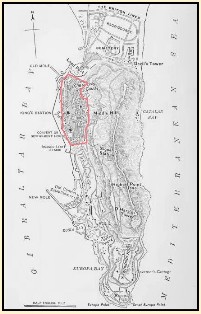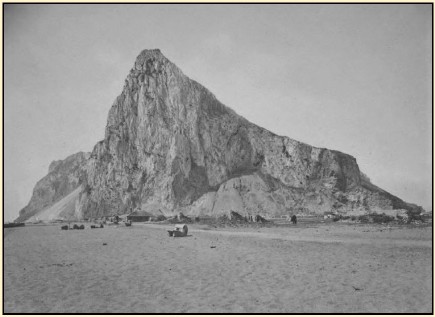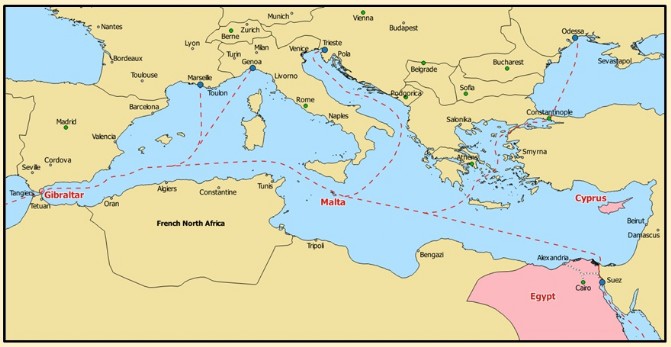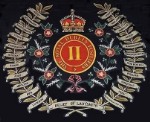Molly's Gibraltar (1880-1886)
On July 21, 1704, during the War of the Spanish Succession, an Anglo-Dutch fleet landed a force of about 1,800 soldiers on the Isthmus of Gibraltar and isolated the town from mainland Spain. Gibraltar at the time was defended by about 150 Spanish troops. Dutch and British warships bombarded the town, its fortifications, and the harbor. The Spanish surrendered on July 24th and all but at most 200 of Gibraltar’s inhabitants left for mainland Spain. The Anglo-Dutch fleet withdrew after leaving behind a British garrison under the command of Prince George of Hesse-Darmstadt (effectively British Gibraltar’s first governor). In October, a Franco-Spanish force tried to expel the British. Gibraltar was besieged until April 1705 when the attackers withdrew. The War of the Spanish Succession concluded in 1713 with the Treaty of Utrecht. The treaty included a provision that made Gibraltar a British possession.
n/ John Drinkwater, A History of the Siege of Gibraltar, 1779-1783, New Edition (London: Murray, 1905).


Henry Field, Gibraltar, 1889.
J.H. Mann from A History of Gibraltar and Its Sieges.

The Mediterranean Region, 1885
British Possessions and Principal Trade Routes
Pages on Major Tweedy's Neighborhood
"... Joyce's Gibraltar is among the most positively described locations in the book and its treatment must surely count as one of the most significant, most atmospheric, not to mention sexiest, treatments of Gibraltar that exist in modern English. ... It appears in Ulysses as a place of layered mythic inheritance, of ambivalence and of gendered desire. Molly's memory turns it into the place of what Jacques Derrida among others have explored as literature's most famously celebratory and communicative 'yes'."n/ Richard Brown, "Molly's Gibraltar: The Other Location in Joyce's Ulysses," in A Companion to James Joyce, edited by Richard Brown (Malden, MA: Blackwell, 2008), 157-58. The reference is to Jacques Derrida, "Ulysses gramophone: hear say yes in Joyce," in Acts of Literature, edited by Derek Attridge (London: Routledge, 1992).The above link will take you to a page on this website where you'll get a view of Gibraltar that's far different from Molly's.These maps show terrain and identify military installations, landmarks, places of interest, as well as features mentioned in Ulysses. Revised January 2023 to include the Campo de Gibraltar and an enhanced Gibraltar Town Plan. Further revised March 2023 to include Carabineros facilities along the Strait and Los Barrios town plan.Sites in Gibraltar referenced in Ulysses, nearly all from the "Penelope" episode. Shown on Charles Warren's 26-foot long model of Gibraltar, built 1865.Information on this unique, nearly isolated, community of fishermen nestled up against the steep slope of the Rock's eastern facing.Molly was glad to see that lot leave Gibraltar.Spanish cavalry at La Roque? Ulysses (Gabler) 18:398-99.A brief look at Gibraltar in 1904. The major geographical difference from the 1880s is at the harbor.Links to Ordnance Survey maps of Gibraltar, c. 1900-1950, on the Garrison Library's website.
Governing Gibraltar
British Gibraltar was established as a fortress commanded by a general who also held the title of "governor." As such, the outpost was simply a military installation and the civilian residents of the peninsula were merely tenants on army property. At first, the governor was subordinate to the Secretary of State for War. In 1801, Parliament gave the Secretary of State for War authority over the Colonial Office, until then subordinate to the Secretary of State for the Home Department. In 1854, Parliament created the Cabinet position of Secretary of State for the Colonies. As a result, the Governor of Gibraltar acquired an additional superior.
At the beginning of the nineteenth-century, in matters relating to civil government, Westminster treated Gibraltar as a garrison town; however, the highest legal authorities viewed the possession as something beyond a mere fortress. During the century, a local civilian administration developed, and the Colonial Office gradually increased its authority over the civilian population. By the mid-nineteenth century the British government viewed Gibraltar as both a crown colony and a military garrison.
n/ Charles Cawley, Colonies in Conflict: the History of the British Overseas Territories (Newcastle upon Tyne: Cambridge Scholars, 2015). The 1842 announcement of Robert Wilson as Gibraltar’s new governor, as published in the London Gazette, contained the words “Governor and Commander in Chief in and over the City and Garrison of Gibraltar.”
Contemporary Looks at Gibraltar, 1845-1900
Following are descriptions of Gibraltar written by visitors and residents during the second half of the nineteenth century.
Chapter from a melodramatic novel by Eliza Frankland published under a pseudonym. She was a daughter of Sir Frederick Frankland, Barrack-Master, South District of Gibraltar, 1843 through 1858. Click on the link and the book's preface and that descriptive chapter will open in a pdf from this website.
Flora Calpensis [Eliza Frankland], The Life of a Rock Scorpion (London: Charing Cross, 1880). This book is now in the public domain.
Sir Frederick's house was at 6 South Mole Parade. Click on the small image and a larger one will open from this website in a popup window.
John Philip, Reminiscences of Gibraltar, Egypt, and the Egyptian War, 1882 (Aberdeen: Wyllie, 1893). This book is now in the public domain.
Army memoir of an Aberdeen police sergeant who served with the 2nd Battalion, Duke of Cornwall's Light Infantry (a regiment mentioned in Ulysses). It's one of the few Victorian Era books on army life written by an enlisted man. Click on the above link to open from this website a pdf with the book's first 30 pages (the author's recollections of Gibraltar). Philip was in Gibraltar during the time that Joyce placed there the Ulysses characters, Major Brian Cooper Tweedy and his daughter Marion (Molly Bloom). In January 1884, the War Office sent Major Tweedy's former unit, 2/Royal Dublin Fusiliers, then stationed in Gibraltar, to Egypt.
John Philip

Note: Philip sailed from Gibraltar for Egypt on the troopship, HMS Malabar. That ship was one of five purpose-built veseels that during the late-19th century, transported British troops along the Portsmouth-Gibraltar-Malta-Alexandria route to India. For more on HMS Malabar and the Indian troop ships, click here and a page from the website, The Queen's Royal Surrey Regiment, will open in a new browser window.
Description of a cab ride through Gibraltar by Arthur M. Horwood. The Illustrated Naval and Military Magazine, April 2, 1888. Note that the publication date is about two years after Molly and her father left the Rock for Dublin. From the Hathi Trust. Click on the above link or icon to the right and the document will appear in a new browser window. It may take some time to load.
Book of short stories set in Gibraltar by Mary Anderson. Published in 1897 by London's Downey & Co. One of the few Late Victorian, English language fiction works set in
Gibraltar. From Google Books. Click on the above link or icon to the right and the document will appear in a new browser window. For a list of fictional works set in late 19th century Gibraltar, click here and an image file from this website will open in a popup window.
The eight stories included in Tales of the Rock suggest Mary Anderson's knowledge was not based on library research, nor even on a short vist as a tourist; but rather, as that of a long-term resident. "The book was published in 1897 and some of Anderson's stories, however overly sentimental and far-fetched to modern ears, are of enough historic interest to warrant a read."
n/ Neville Chipulina, "1897 - Mary Anderson," The People of Gibraltar (August 2012).
"Only one of the stories, 'Dwellers in Linea,' contrives to get a picturesque and novel interest with its account of running contraband tobacco by the help of trained dogs, who swim ashore carrying it. The same tale relates a most remarkable instance of Spanish cruelty and callousness which I should hesitate about believing. But, upon the whole, the book is a collection of trivial enough little tales, which, however, are not tedious, and do not sin against either taste or grammar.
n/ The Academy 52 (July-December 1897), Suppl. p. 71.
Richard Gillham Thomsett, A Record Voyage in H.M.S. Malabar and Reminiscences of "The Rock" (London: Digby, Long, 1902). This book is now in the public domain.
Thomsett, in the second part of this book, paints an unflattering, but humorous picture
of working-class and lower-middle-class, llanito speaking, native Gibraltarians. He refers to such native-born as Gibraltarian Spaniards. Thomsett, an army surgeon, had travelled to the Rock, and onward to India, on the troopship, HMS Malabar.
Click on the above link for the Reminiscences part of the book in a pdf from this website. It will open in a new browser window. Click on the small ship photograph for a larger image of HMS Malabar, digitized by the State Library of Victoria, Australia. It will open in a popup window.
Download from Major Tweedy's Neighborhood
To download the file click on the document's name. The file will open in a new browser window.
Report by J.L.A. Simmons, Inspector-General of Fortifications, on Gibraltar's defenses. GibFortsReport.pdf (1mb file).
Description of the Royal Navy at Gibraltar for the three years beginning from January 1881. From Edmund R. Fremantle, The Navy As I Have Known It (London: Cassell, 1904). Fremantle was the commanding officer of Naval Station Gibraltar for that period. His memoir was digitized by the University of Pittsburgh for the Internet Archive. Fremantle.pdf (664 kb).
List of all governors, Spanish names for streets, and a directory of the Gibraltar Civil Service. Misc_Dir_1888 (613 kb).
In a 196 kb MS Excel spreadsheet created by the library (Gibraltar-Room-Inventory.xlsx).
Download from Other Websites
Click on the link for the document. Click on the icon to go to the website's home page.
Dr. Sawchuk, anthropologist with the University of Toronto (click icon to the right), has studied Gibraltar for decades. The above link is to his bibliography for Gibraltar research.
Rafael I. Garcia Leon and Francisco Javier Quintana-Alvarez, "Bullfighting in Ulysses," Papers on Joyce 7/8, Asociacion Espanola James Joyce (2001-02). On the website Iberjoyce.
Links to Other Websites
Note: The webpages will open in new windows.
Click on the link to go to that page of the website. Click on the icon to go to the website's home page.
The University of Aberdeen's online exhibition of the George Washington Wilson photography collection. Mann, who photographed Gibraltar, was employed by Wilson's studio. In the collection there are 283 images of Gibraltar. Note that if "you wish to reproduce an image in electronic or any other form ... you must obtain the written permission of the University of Aberdeen in advance." See the university's terms of use.
Maintained by the Gibraltar National Archives. In addition to database access, you can view and download scans of the original, enumerators' books. There are numerous errors in the database transcripts so it's best to view the "Original Record" for persons of interest. Original records are large pdf files of the enumerators' books that will take a long time to download. Also, some files contain records from two separate enumerations. For example, the 1878 and 1881 records are in the same pdf files.
The above link is to the page "Gibraltar Inhabitants" which covers civil records. For military records (not as complete as civil records) click on this link then position the cursor over the small .Records. button.
Also, see "Historical Account" of the census by Richard J.M. Garcia. Click on the icon to the right for the home page of the Gibraltar National Archives. Note that many of the links are broken, especially those to images.
Downloadable images of a large scale map probably made by the Royal Engineers. The map is in the UK National Archives, MPH 1/23.
The title link is to a page on Wikimedia Commons. You may also open that page by clicking on the icon to the right. The map can be downloaded as jpg images with six resolutions from 320x116 pixels to 5,764x2,098 pixels. The highest resolution file is 4.9 MB in size.
Outstanding blog by Neville Chipulina. The link is to the table of contents which is arranged in historical, chronological order. "James Joyce - Molly Bloom's Gibraltar" is indexed at 1885.
There is no copyright notice on this blog but I would contact the owner for permission for other than "fair use." Also, many of the images on this website are property of third parties. If you wish to reproduce any of such images in electronic or any other form, you should obtain permission from the owner of the digital file.
Excerpts from To Gibraltar and Back in an Eighteen-Tonner (London: W.H. Allen, 1888). The author was "One of the Crew" and the yacht's owner was Alfred James Corry, a civil engineer. Corry's parents were Dubliners who moved to London before their children were born. At the time of the Gibraltar voyage, Corry was age 27. He died seven years later and the yacht, Chiripa, was inherited by his brother Edward, a barrister.
n/ Lloyd's Yacht Register, 1888; Obituaries, The Engineer 110 (April 8, 1892); "The Corry Family" from the website of Friends of Hastings Cemetery, friendsofhastingscemetery.org.uk.
Gibraltar Reference Material Consulted by Joyce
Joyce never visited Gibraltar. While all his sources for the locale are not known, scholars are confident that Joyce consulted the following books for writing of Gibraltar in Ulysses: The annual Gibraltar Directory and Guide; Stephens' Gibraltar and its Sieges; Field's Gibraltar; O'Shea's Guide to Spain and Portugal. Other likely references are Gibraltar and the West Indies by John Lang, A History of the Siege of Gibraltar by John Drinkwater, Ford's Handbook for Travellers in Spain, Jewish Encyclopedia, and The Traveller's Hand-Book for Gibraltar by "an old inhabitant."
n/ Richard Brown, "Molly's Gibraltar: The Other Location in Joyce's Ulysses" in A Companion to James Joyce, edited by Richard Brown (Oxford: Blackwell, 2008); James Van Dyck Card, "A Gibraltar Sourcebook for 'Penelope'," James Joyce Quarterly 8, no. 2 (Winter 1971):163-75; Phillip Herring, ed., Joyce’s Notes and Early Drafts for Ulysses, Selections from the Buffalo Collection (Charlottesville: Univ. Press of Virginia, 1977), V.A.2.
The Gibraltar Directory and Guide was founded in 1877 by George J. Gilbard, a British army officer stationed at Gibraltar first with his regiment, then on the staff of the Gibraltar infantry brigade, and finally as an aide-de-camp to the governor. Gilbard wrote the original narrative material which changed little over the years. Gilbard died in 1887, his widow became owner of the Directory, and Cavendish Boyle, the Colonial Secretary for Gibraltar, became the publication's editor. A digitized version of the 1888 edition is the most recent volume available for public download. The full title of the 1888 edition is A Popular History of Gibraltar, Its Institutions and its Neighbourhood on Both Sides of the Straits and A Guide Book.
Philip Herring, in his transcription of Joyce's notes for Ulysses in the Lockwood Memorial Library, State University of New York at Buffalo, states: "I have not been able to establish which volumes of this annual publication Joyce used." Robert Adams, another Ulysses scholar, concluded that "Joyce used several numbers, if not a whole run of Gibraltar Directories." Adams identified two of the editions used by Joyce: 1884 and 1912.
n/ Herring, ed., Joyce’s Notes and Early Drafts for Ulysses, 56-57; Robert M. Adams, Surface and Symbol (New York: Oxford Univ. Press, 1962), 231.
The Buffalo Notebooks indicate another likely source for Joyce: The British Empire Series, Vol. 5 (London: Kegan Paul, Trench, Trubner, 1902). Herring's transcription shows as an entry in Notebook V.A.2, Page 1:
"Boyle Gibr. / Br. Emp. Serv '02"
Cavendish Boyle authored the Gibraltar entry that appears in Volume 5 of The British Empire Series. At the time, Boyle was governor of the British North American colony of Newfoundland, which was separate and independent of the Dominion of Canada. Ulysses scholars have eroneously taken this notation as a reference to the 1902 edition of the Gibraltar Directory.
n/ London Gazette, February 24, 1888, February 20, 1894, March 5, 1901; Reuters Wire Service, July 7, 1888; James K. Hiller, "Boyle, Sir Charles Cavendish," in Dictionary of Canadian Biography, Vol. 14, University of Toronto/Universite Laval, www.biographi.ca.
Download from Major Tweedy's Neighborhood
This document is in a .pdf file. To download the file click on the document name. The file will open in a new browser window.
John Lomas, ed. Edinborough: Black, 1889, 149-59. Title page and entry for Gibraltar in a 1.7mb file, OShea_Gibraltar_1889.pdf. Digitized by the Internet Archive.
Documents on Other Websites
All these documents are in .pdf files and are fully readable. To download the file click on the document name or its website icon. The file will open from the other website in a new browser window. See Download Instructions if you're unfamiliar with the website.
London: Nelson, 1900. From the Internet Archive.
London: Chapman & Hall, 1889. From the Internet Archive.
Gibraltar: Garrison Library, 1883. This publication series is commonly known as "The Gibraltar Directory and Guide." From the Hathi Trust. Partner login credentials required to download the whole book. The full series is in the Royal Commonwealth Society Library at Cambridge University. The Gibraltar Garrison Library, has a good-sized collection but is incomplete. For the 1888 edition (Boyle & Bandury, eds.), click here.
From 1888 through 1894, Cavendish Boyle and Rudolph, or Rodolfo (Rodolphus) Bandury were the Directory's co-editors. Boyle, a career Colonial Service officer, was posted to British Guiana in 1894 and R. Bandury edited the publication until replaced by Benedict R. Miles in the early 20th century. Bandury, a native Gibraltarian, was a long-serving, Deputy Librarian of the Garrison Library and held that position until the outbreak of the First World War. The 1888 directory shows Bandury honorary secretary of the Gibraltar Club, one of the colony's two clubs for the civilian elite (the Exchange Club being the other). In 1892, Boyle and Bandury purchased the publication from Mrs. Gilbard, and two years later, when Boyle left Gibraltar, Bandury became sole proprietor. Bandury subsequently sold out to Benedict Miles, a son of the Gibraltar printer and publisher, William Miles.
n/ Census of Gibraltar, 1968, 1891, 1901, 1911, 1914; Boyle, "Gibraltar" in The British Empire Series, Vol. 5.
Isadore Singer, Managing Editor (New York: Ktav Publishing). Gibraltar entry by Joseph Jacobs.
In The British Empire Series, Vol. 5 (London: Kegan Paul, Trench, Trubner, 1902), 60-81. From the Internet Archive.
London: Murray, 1905. From the Internet Archive.
Plan de Gibraltar, J.D. Barbie du Bocage. High resolution image of a beautiful map of Gibraltar at the time of the Great Siege. This page on wikimedia.org will open in a new browser window. The digital image is 2.5 MB in size.
New York: Stokes, [1909]. From the Internet Archive.
Gibraltar entry by Charles Francis Atkinson. From the Internet Archive. Herring believes Joyce consulted the Gibraltar entry as its map is similar to one in Joyce's notebooks. Herring, Joyce's Notes and Early Drafts for Ulysses, 269.
Richard Ford, A Handbook for Travellers in Spain, Part II, 6th Ed. (London: John Murray, 1882), 370-80. From the Internet Archive. Richard Ford died in 1858; however, his publisher continued to update the book and released new editions.
London: Cowie, Jolland, 1844. From Google Books. Joyce may have used this work as a reference for Gibraltar.
Neville Chipulina has posted on his blog, The People of Gibraltar, extracts from this book. He has also added many illustrations plus interesting commentary. These can be viewed by clicking on the following links. Click on the icon to the right to link to the blog's contents page.



